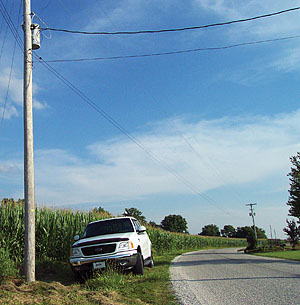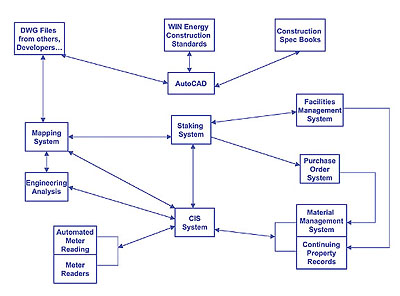 WIN Energy – based in Vincennes, Indiana – is a 16,000 member rural electric cooperative operated by 42 employees working out of three different offices and covering approximately 2,500 miles of distribution lines. With system loads growing at an average of 15 percent over the last several years, WIN Energy’s management team made a strategic decision to meet this challenge and keep rates low by investing in technology solutions, rather than increasing staff. Taking advantage of new technologies has helped the utility increase productivity, free up staff time, improve customer satisfaction and facilitate the exchange of information. The solutions implemented include MiniMax’s StakeOut for field design and work order automation, LookOut for utility-wide map viewing, an ESRI GIS (Geographic Information System), Hunt Technologies AMR (automated meter reading), NISC’s CapsXL+ financial accounting and CIS (Customer Information System) and Milsoft’s Engineering Analysis (Windmill) with plans to add Milsoft’s DisSPatch Outage package.
WIN Energy – based in Vincennes, Indiana – is a 16,000 member rural electric cooperative operated by 42 employees working out of three different offices and covering approximately 2,500 miles of distribution lines. With system loads growing at an average of 15 percent over the last several years, WIN Energy’s management team made a strategic decision to meet this challenge and keep rates low by investing in technology solutions, rather than increasing staff. Taking advantage of new technologies has helped the utility increase productivity, free up staff time, improve customer satisfaction and facilitate the exchange of information. The solutions implemented include MiniMax’s StakeOut for field design and work order automation, LookOut for utility-wide map viewing, an ESRI GIS (Geographic Information System), Hunt Technologies AMR (automated meter reading), NISC’s CapsXL+ financial accounting and CIS (Customer Information System) and Milsoft’s Engineering Analysis (Windmill) with plans to add Milsoft’s DisSPatch Outage package.Single Vendor vs. Best of Breed
Before starting a large scale automation project, utilities need to choose between two fundamentally different philosophies about how to most effectively share data throughout the organization: Single Vendor or Best of Breed. The Single Vendor approach uses one supplier to provide all software to the utility. In this approach, data transfers between different modules are handled by the single chosen vendor. In contrast, the Best of Breed philosophy enables the utility to choose the vendor that best meets their needs for each application. This does require multiple vendors to be involved in transfers of data from one system to another.
Generally, the Single Vendor approach – purchasing software that is fully integrated – forces utilities to compromise on the quality of the different modules. A vendor may be strong in accounting, but weak in staking, mapping, automated meter reading, etc. In some cases, a vender may indeed offer a module that is the market’s best, but rarely can they offer the best technology in each of the application categories that a utility needs. Therefore, the utility is not able to accomplish its overall corporate goals. One department may get good technology, but other departments often have to settle for less than adequate tools. The single vendor approach also creates risk by forcing the utility to be dependant on one software company. If the software company goes out of business, is acquired, or runs into management or production problems, the utility could be left in a precarious position.
Previously, the Best of Breed approach, obtaining software that is the best in each niche, whether it is in accounting, staking, mapping, AMR, etc., had presented its own challenges. Purchasing the best software available required custom interfaces or integration between the various systems. Getting software vendors to communicate willingly among themselves can be very difficult, especially if they sell competing products. These hard-won custom interfaces often became unusable as soon as one vendor or the other upgraded its software to the latest version. When this happened, a new interface had to be written to bring the electric utility back to where it was before the upgrade, costing the company time in both lost resources and lost production.
Historically, small utilities were often enticed by the one-stop-shop vendors because they lacked the internal I/T resources to support multiple systems. This is direct contrast to larger utilities, which have almost always chosen their applications based on the best fit and greatest functionality criteria. In today’s environment, because of the higher performance demands placed on all utilities, having the best tools enterprise wide is essential, necessitating a best of breed strategy.
MultiSpeak’s Best of Breed Breakthrough
While many electric utilities today are exploring integrating or interfacing a few selected software systems, WIN Energy REMC and a few other electric utilities have been actively pursuing interfacing their different software system-wide. In 2000, WIN Energy REMC participated in a Cooperative Research Network (CRN) study testing the viability of interfacing different software systems using a software specification called MultiSpeak. Based on the success enjoyed to date using this standard, the cooperative now only purchases MultiSpeak compliant products.
MultiSpeak is a schema that establishes a set of standard interface specifications and defines data entities and their attributes. For example, the "Customer" entity has 14 attributes, including: customer first name, last name, home phone number, billing address, and customer id number. In version 1.1, MultiSpeak defined data transfers between different applications, like CIS, staking, AMR, in a batch process using XML files. In MultiSpeak 2.2, the latest version, data is transferred in real time between defined functions within a program. So instead of just linking the staking package to the CIS package, a utility can link its staking system to either its accounting system or its customer billing system or both. The change to function based transfers allows for the fact that not every CIS, GIS or staking software has exactly the same features and functions. (Please visit www.multispeak.org for more details.)

WIN Energy’s Chosen Approach
First, WIN Energy looked at all of the different internal processes it wished to streamline, including mapping, outage management, staking and meter reading. Then, it looked at them together from an enterprise wide perspective. When WIN Energy looked at the big picture, the cooperative team asked, "What processes could feed other processes?" Going through the exercise of examining all the data flows was essential in developing a plan for utility-wide automation.
After reviewing the overall process, WIN Energy decided the top priority was to find a staking and work order automation package that would serve as the single point of entry for all its asset and work order information. This system would need to interface with the existing NISC CIS and financial software. The next steps were to implement a robust GIS and to put in an automated meter reading system. In subsequent phases, WIN Energy decided to integrate staking and GIS, use the GIS to feed data to engineering analysis and outage management, and to use data collected in automated meter reading to drive billing and outage management.
WIN Energy chose MultiSpeak as the vehicle to enable a Best of Breed strategy and optimize the way the cooperative does business. WIN Energy can now select the various software technologies that are the best fit for the utility and, as long as the software packages are MultiSpeak compliant, they will function together regardless of software version upgrades. WIN Energy’s first MultiSpeak implementation between its accounting system, NISC’s CAPSXL+, and its automated field staking package, MiniMax’s StakeOut, was both highly successful and its first step towards a truly system-wide approach.
Since this first step, WIN Energy has been working with additional vendors – Environmental Systems Research Institute (ESRI), Hunt Technologies, and Milsoft Integrated Solutions (Milsoft). ESRI’s ArcGIS software has been used in conjunction with MiniMax’s StakeOut technology to create a truly integrated application. Additional plans include updating Milsoft Utility Solutions Windmill Engineering Analysis (EA) and DisSPatch OMS packages. WIN Energy was one of the first Hunt Technologies TS2 implementations. This system will be tied, using MultiSpeak, to both the CIS and OMS packages. All of the processes link to each other so that WIN Energy is well on its path to accomplishing all of the above.
Resulting Benefits
In terms of immediate benefits, the integration between MiniMax’s staking and NISC’s CIS and billing system has allowed WIN Energy to automate the MMS (Material Management System) and CPR’s (Continuing Property Records). The labor required for job close outs was reduced from more than 40 man-hours per month to just minutes per week. This direct productivity gain was achieved without redundant data entry, saving additional time and conforming to WIN Energy’s strategic objective to use technology to hold down labor costs.







